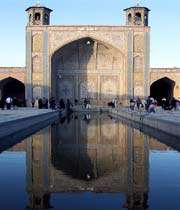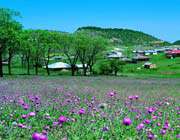Jahan - nama village
Not all villages in different parts of Iran are permanently residential. Some of them play the role summerhouses for residents of near cities, and therefore are left during autumn and winter. Jahan-nama village is one such village. This village is 60 km south east of the city of Kordkuy, 85 km away from Gorgan, and is on the skirts of a mountain with the same name. Jahan-nama Mountain has its peak with the altitude of 3086 meters above sea level. Jahan-nama village enjoys moderate summers but cold winters. The low temperature and snowing during fall and winter make the people leave the village. However, as mentioned before, people of Gorgan and Kordkuy summer in this village during the two seasons of spring and summer. Therefore, during these two seasons, Jahan-nama not only hosts native villagers but many tourists and guests as well.
Due to its natural condition, special weather, and being situated in Jahan-nama protected zone, this village has magnificent landscapes and exquisite sceneries. Mountain heights, springs, rivers, and forests have given the region unique beauty, especially during springs and summers.
Regarding natural wild life, the village and the regions in its vicinity are one of the significant regions in Iran. Mammals like chamois, goat, ram, leopard, bear, wolf, weasel, and jackal, besides some invaluable species of such birds as partridge, eagle, and osprey constitute the fauna of the region.
The flora of the region relies greatly on the main rivers namely Chaharbaaq, Maqzi, Torkat, and also numerous springs such as Shahpasand, Torkat, Maqzi, Maarsang, Morad-cheshmeh, Haaji-abad, and the like. Jahan-nama region is covered with different types of pasture plants, medicinal plants, meadows, shrubberies, and species of beech, sagebrush, borage, and so on.
The existence of rich meadows has led to thriving animal husbandry in Jahan-nama village, and as a result, various products such as milk, butter, wool, and meat are produced and processed in the village. Some parts of Jahan-nama village farms are cultivated in spring and summer, and among major agricultural products mention can be made of wheat, potato, and vegetables.
House construction in the village has been seriously impacted by the inhabitants' activities and their life style. Thus, most houses are built in the same style as the villas in the country sides, and have a suitable space of resting for the guests during spring and summer. Jahan-nama has a sparse residential texture whose houses are usually made of wood, and their roofs are covered with galvanized sheets to form gable roofs. However, old buildings are made of clay, brick, and wood. This village is accessible via a road coming from the two cities of Gorgan and Kordkuy.
Of the old and historical monuments of Jahan-nama region, mention can be made of the ancient cemetery of Kamar-sarak, the mausoleum of Imamzadeh Razi-o Marzieh, and the tower of Radakan-e Gharbi. Residents of this village speak in the two Mazandarani and Katuli dialects and are Shiite Muslims..






